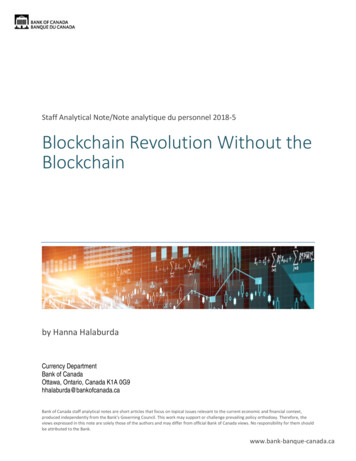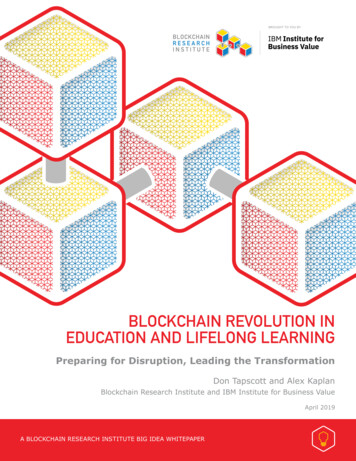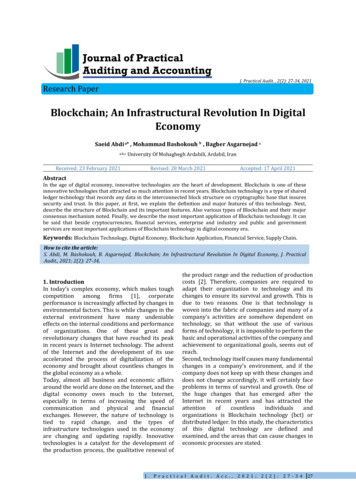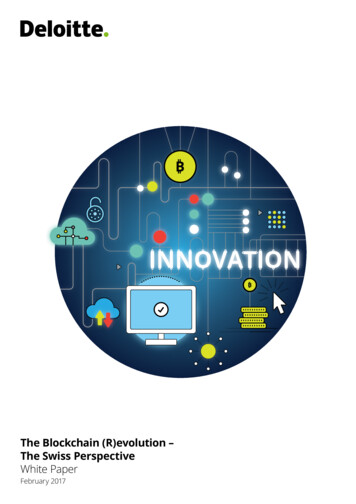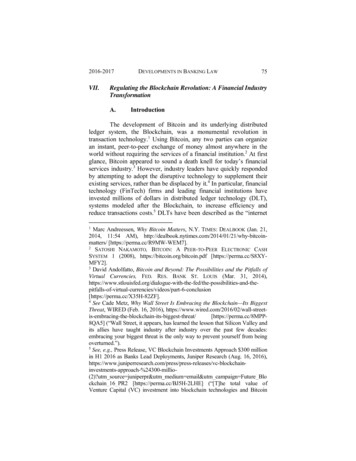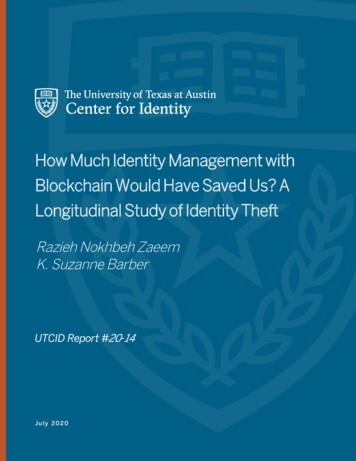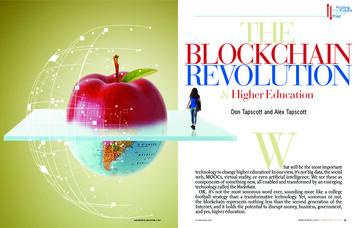
Transcription
Findingthe Futurein thePastTHEBLOCKCHAINREVOLUTION& Higher Education Don Tapscott and Alex TapscottWhat will be the most importanttechnology to change higher education? In our view, it’s not big data, the socialweb, MOOCs, virtual reality, or even artificial intelligence. We see these ascomponents of something new, all enabled and transformed by an emergingtechnology called the blockchain.OK, it’s not the most sonorous word ever, sounding more like a collegefootball strategy than a transformative technology. Yet, sonorous or not,the blockchain represents nothing less than the second generation of theInternet, and it holds the potential to disrupt money, business, government,and yes, higher education.ILLUSTRATION BY ANN CUTTING, 2017e r. e d u c a u s e . e d uM A R C H / A P R I L 2 0 1 7 E D U C A U S E r e v i e w 11
The Blockchain Revolution and Higher EducationThe opportunities for innovators inhigher education fall into four categories:nnnnIdentity and Student Records: How weidentify students; protect their privacy; measure, record, and credentialtheir accomplishments; and keepthese records secureNew Pedagogy: How we customizeteaching to each student and createnew models of learningCosts (Student Debt): How we value andfund education and reward studentsfor the quality of their workThe Meta-University: How we designentirely new models of higher education so that former MIT PresidentChuck Vest’s dream can become areality1The blockchain may help us changethe relationships among colleges anduniversities and, in turn, their relationship to society.Let us explain.What Is theBlockchain Revolution?The Internet today connects billions ofpeople around the world, and certainlyit’s great for communicating and collaborating online. But because it’s built formoving and storing information ratherthan value, it has done little to changehow we do business. When professorssend their students information such asan e-mail, lecture notes, a PowerPointpresentation, or an audio recording ofa lecture, they’re really sending a copy,not the original. It’s OK (and indeedadvantageous) for people to print a copyof their PowerPoint file, but it’s not OKto print, say, money or diplomas. Sowith the Internet of information, wehave to rely on powerful intermediariesto exchange things of value. Governments, banks, digital platforms (e.g.,Amazon, eBay, and AirBnB), and colleges and universities do the work ofestablishing our identity, vouching forour trustworthiness, and helping us toacquire and transfer assets and settle thetransactions.12 E D U C A U S E r e v i e w M A R C H / A P R I L 2 0 1 7Overall, they do a pretty good job—butthere are limitations. They use centralized servers, which can be hacked. Theytake a piece of the value for performingthis service—say, 10 percent to send somemoney internationally. They capture ourdata, not just preventing us from usingit for our own benefit but often undermining our privacy. These intermediaries are sometimes unreliable and oftenslow. They exclude two billion peoplewho don’t have enough money to justifya bank account, let alone an education.Most problematic, they are capturing thebenefits of the digital age asymmetrically.What if there was an Internet ofvalue—a global, distributed, highly secureplatform, ledger, or database where wecould store and exchange things of valueand where we could trust each otherwithout powerful intermediaries? Thatis the blockchain. Collective self-interest,hard-coded into this new native digitalmedium for value, would ensurethe safety, security, and reliabilityof our exchanges online. Trust isprogrammed into the technology,which is why we call blockchainthe Trust Protocol.Why should you care? Maybeyou’re a music professor whowants artists to make a living offtheir art. Perhaps you’re an immigrant who is sick of paying big fees tosend money home so that your childrencan go to college in your ancestral land.Or maybe you’re a parent fed up with thelack of transparency and accountabilityof the politicians and political appointees responsible for higher educationin your state. Or perhaps you’re a socialmedia user who thinks all the data yougenerate might be worth something—toyou—and that your privacy matters.Even as we write, innovators are buildingblockchain-based applications that servethese ends. And these apps are just thebeginning.It turns out that every business,institution, government, and individualcan benefit in profound ways. Howabout the corporation, a pillar of modern capitalism? With the rise of a globalpeer-to-peer platform for identity, trust,reputation, and transactions, we will beable to reengineer deep structures of thefirm, for innovation and shared valuecreation. We’re talking about building21st-century companies that look morelike networks than the vertically integrated hierarchies of the Industrial Age.The whole financial services industry isalready being reinvented by the blockchain, and others will soon follow. Howwell does today’s college or universityprepare students for such a future?How about the Internet of Things?In the not-too-distant future, billions ofsmart things in the physical world willbe sensing, responding, communicating,sharing important data, and generating,buying, and selling their own electricity,doing everything from protecting ourenvironment to managing our health. Itturns out that this Internet of Everythingwill need a Ledger of Everything.One of the biggest opportunities ofthe blockchain is to free us from the gripof a troubling prosperity paradox. Theeconomy is growing, but fewer peopleare benefiting. Rather than trying to solvethe problem of growing social inequality through redistribution alone, we canchange how wealth—and opportunity—ispredistributed in the first place, as peopleeverywhere, from farmers to musicians,can use this technology to share morefully in the wealth they create.
The Blockchain Revolution and Higher EducationBlockchain, Identity,and Student RecordsPKI is an advanced form of asymmetriccryptography, where users get two keys“Today you need an organization withthat don’t perform the same function:endowed rights to provide you withone is for encryption and the other foran identity,” said Carlos Moreira ofdecryption. Hence, they are asymmetric.WISeKey.2 This process of identificationThe Bitcoin blockchain is now the largestusually begins with a birth certificatecivilian deployment of PKI in the world,issued by a state-licensed medical professecond overall to the U.S. Departmentsional. From that day forward, the babyof Defense common access system. 5begins to accumulate personal data,Sony Global Education has adapted thiswhich will include academic achievetechnology into what it is calling an openments in analog form.data exchange protocol, through whichThe first challenge is to maintaintwo parties anywhere in the world canthe privacy and security of data storedsecurely share official academic records.6digitally by those academically accredBut without the exact two keys, a hackerited institutions. In 2013, the Educationcannot access the data.Advisory Board (EAB) published a list ofA second challenge to address is157 strategies for collecting data aboutvalidity. At a time when information isstudents and alumniabundant, fleeting,for colleges and unimutable, beingAs long as society values andversities to exploit inable to verify a jobexisting credentials,fundraising efforts,prospect’s claims isand institutions havebecoming increasand students will paybecome good at doingimportant toto get those credentials inglyso.3 When it comesemployers. Accordingat recognized institutions to CareerBuilder, 57to protecting thesedata, however, colpercent of job appliof higher education,leges and universihave embelthen the college/university cantsties are no less vullished their skill set,will remain a gatekeeper and 33 percent havenerable than otherlarge organizations.lied about their acato opportunity.The University ofdemic degree. 7 NotCalifornia–B erkeley, Ohio Statesurprising, employers are wanting toUniversity, the University of Wisconsin–see official college transcripts. However,Milwaukee, and Kirkwood Communitywhen it comes to processing requests,College were among those hacked inuniversities often charge transactionrecent years. Yale University accidenfees. At MIT, for example, “the base costtally published confidential informationfor a transcript is 8.00” with a 2.00online, and Indiana University hostedhandling charge for each transcriptsuch data on an unprotected site. Theordered online.8 Sony’s solution couldUniversity of Utah Hospitals and Clinics,make the transfer of such informationStanford University, and the Universityquick and comparatively cost-free.of Miami stored data on laptops or dataImagine how such a system couldtapes that were later stolen.4benefit, say, refugees who were seekingThe blockchain can be programmedto continue their education or find a jobto record virtually everything of valuein a new country.and importance to humankind, startingA third issue is time. In the Unitedwith birth certificates and moving on toStates, only 25 percent of students attendeducational transcripts, social securitycollege full-time at residential campuses.cards, student loans, and anything elseThe rest are juggling work and family.that can be expressed in code. The blockThese part-time students take twice aschain uses public key infrastructurelong to graduate, and only 25 percent(PKI) for establishing a secure platform.of them actually earn a degree.9 Initia14 E D U C A U S E r e v i e w M A R C H / A P R I L 2 0 1 7tives such as OpenBadges (https://openbadges.org/), Blockchain Certificates(http://www.blockcerts.org/), and Learning Is Earning 2026 (http://www.learningisearning2026.org/) are exploring waysto reward students with credentials foreverything they learn, no matter the setting. If a parent teaches his or her childhow to change the oil in a car, that counts(and the parent gets teaching credit). If astudent learns a new skill at work, orhas to collaborate to finish a task, or ismanaging others, that goes on the learning transcript too. The MIT Media Labstarted hashing digital certificates ontothe blockchain to permanently denotemembership and to reward communitymembers for their valuable contributions to the lab’s work.10 Students arenot getting just a grade; they are gettinga credential, which they can put to useimmediately on the job market.Blockchain and the New PedagogyAs long as society—or at least today’semployers, including governments—values existing credentials, and studentswill pay to get those credentials at recognized institutions of higher educationrather than pursue alternatives, thenthe college/university will remain a gatekeeper to opportunity.But the credential and even the prestige of a higher education institution arerooted in its effectiveness as a learninginstitution. If colleges and universitiesbecome seen as places where learningis inferior to other models or, worse,as places where learning is restrictedand stifled, then the role of the campusexperience and the credential itself willbe undermined. Attending a college oruniversity is too costly to be simply anextended summer camp.Campuses that embrace the newmodels become more effective learningenvironments and more desirable places.Computer-based learning, for instance,can free up intellectual capital—on thepart of both professors and students—tospend their on-campus time thinking,inquiring, and challenging each other,rather than just absorbing information.
The Blockchain Revolution and Higher EducationIf there is one thing that’s due forinnovation in higher education, it’s themodel of pedagogy. To start with, big universities are still offering the broadcast model of learning, in which theteacher is the broadcaster and the student is the supposedly willing recipientof the one-way message. It goes like this:“I’m a professor, and I have knowledge.Get ready; here it comes. Your goal isto take this data into your short-termmemory so that you can recall it to mewhen I test you.”The definition of a lecture has becomethe process in which the notes of theteacher go to the notes of the studentwithout going through the brains ofeither. This is no longer appropriate forthe digital age and for a new generationof students who represent the future oflearning. Young people want to conversewhen they learn. They like to share.Immersed in digital technology, they arekeen to try new things, often at highspeed. They want their education to be fun and interesting. So they shouldenjoy the delight ofdiscovering thingsfor themselves.It’s true that colleges and universities are trying toupdate this broadcast model—throughessays, hands-on labs,and even seminar discussions. And of course, manyprofessors are working hard tomove beyond this model. However, itremains dominant overall. The professors who remain relevant will have toabandon the traditional lecture and startlistening and conversing with the students. To begin, students could achievethe mastery of knowledge (anythingwhere there is a right or wrong answer)by working with interactive, self-pacedcomputer learning programs outside theclassroom, freeing students and facultyalike to spend class time on the thingsthat matter: discussion, debate, and collaboration around projects.16 E D U C A U S E r e v i e w M A R C H / A P R I L 2 0 1 7We also need to be clear on the purpose of higher education. It’s not aboutskills, and to a certain extent, it’s not evenabout knowledge. What counts thesedays is the capacity to learn throughoutlife; to research, analyze, synthesize,contextualize, and critically evaluateinformation; to apply research in solving problems; and to collaborate andcommunicate.So how can blockchains help? Consider the case, noted above, of VitalikButerin, the founder of the Ethereumblockchain. Like many teenagers, Buterin“spent ridiculous amounts of time on theInternet,” reading about different ideasthat were heterodox, out of the mainstream.11 Ask him which economists helikes, and he rattles off Tyler Cowen, AlexTabarrok, Robin Hanson, and BryanCaplan. He can speak on the works of thegame theorist Thomas Schelling and thebehavioral economists Daniel Kahneman and Dan Ariely. “It’s actuallysurprisingly useful howmuch you can learn foryourself by debatingideas like politicswith other peopleon forums. It’s asurprising educational experienceall by itself,” hesaid. The topic ofbitcoin, he noted,kept coming up.“I had all these different interests, and somehowbitcoin seemed like a perfectconvergence. It has this math. It has itscomputer science. It has its cryptography.It has its economics. It has its political andsocial philosophy. It was this communitythat I was immediately drawn into,” hesaid. “I found it really empowering.” Hewent through the online forums, lookedfor ways to own some bitcoin, and discovered a guy who was starting up a bitcoinblog. “It was called Bitcoin Weekly, and hewas offering people five bitcoins to writearticles for him. That was around fourdollars at the time,” Buterin said. “I wrotea few articles. I earned twenty bitcoins.I spent half of them on a T-shirt. Goingthrough that whole process, it felt almostlike working with the fundamentalbuilding blocks of society.” How manystudents have that experience in college?By the end of that year, Buterin wasspending ten to twenty hours a weekwriting for another publication, BitcoinMagazine. “When I was about eightmonths into university, I realized thatit had taken over my entire life, and Imight as well let it take over my entirelife. Waterloo was a really good universityand I really liked the program. My dropping out was definitely not a case of theuniversity sucking. It was more a matterof, ‘That was fun, and this is more fun.’It was a once-in-a-lifetime opportunity,and I just basically couldn’t let it go.” Hewas only seventeen years old.Buterin is a natural-born leader, inthat he pulls people along with his ideasand his vision. Shouldn’t the universityexperience cultivate these assets ratherthan get in the way of them?In 2011, the technology entrepreneurand investor Peter Thiel launched histwo-year fellowship program for “youngpeople who want to build new ’s target audience consists of students who “skip or [drop] out of collegeto receive a 100,000 grant and supportfrom the Thiel Foundation’s network offounders, investors, and scientists.” Theapproach is similar to Buterin’s: studentslearn by working on something theycare about, such as clean water. Thus far,Thiel Fellows have started more than 60companies with a combined value of 1.1billion. Blockchains provide a platformfor such collaboration, not just trackingpeople’s individual contributions butalso rewarding them for results.A good model for classroom collaboration is Consensus Systems(ConsenSys ), one of the first Ethereumsoftware-development companies. It isbreaking new ground in managementscience along the lines of holacracy, a collaborative rather than hierarchicalprocess for defining and aligning thework to be done. Among those holacratic
tenets are “dynamic roles rather than traditional job descriptions; distributed,not delegated authority; transparentrules rather than office politics; and rapidreiterations rather than big reorganizations,” all of which describe how blockchain technologies work.12 How ConsenSys is structured, how it creates value,and how it manages itself differs not onlyfrom the typical classroom but also fromthe typical online course.For the most part, members of ConsenSys choose two to five projectsto work on. No top-down assignments.There is no boss. Everyone owns a pieceof every project directly or indirectly: theEthereum platform issues tokens thatmembers can exchange for Ether andthen convert into any other currency.The goal is to achieve a balance betweenindependence and interdependence. Forthe classroom, the watchwords are agility, openness, and consensus: identify whatneeds to be learned, distribute the loadamong the students eager and able to doit, agree on their roles, responsibilities,and rewards, and then codify these rightsin smart contracts. Teachers and studentsalike would need training to participatein such a system.Blockchain and Costs(Student Debt)Many educators have a problem with theidea of education as big business, and yetcompanies like Pearson and McGrawHill make their fortunes by providing the classroom content, additionalteacher training, classroom and schooladministration systems, and the testingcontent and platforms—the results ofwhich lead to credentials, not just of highschool diplomas and college entrancebut of individual licensures and professional certifications. These companieshave considerable budgets for lobbyingfederal and state legislators.Let’s look at the numbers. From1995 to 2015, the average tuition andfees at private colleges and universities increased 179 percent. Tuition andfees for out-of-state students at publicuniversities jumped 226 percent, ande r. e d u c a u s e . e d uHow Blockchains Establish TrustDigital assets—everything from money, stocks, bonds, and intellectual property to music,art, loyalty points, and student records—are not all stored in a central place: they’redistributed across a global ledger, using the highest level of cryptography. When atransaction is conducted, it’s posted globally, across millions of computers. Around theworld is a group of people called miners who have massive computing power at theirfingertips—10 to 100 times bigger than all of Google worldwide. Every 10 minutes, kindof like the heartbeat of a network, these miners assemble all the transactions from theprevious 10 minutes into a block. Then the miners compete to solve a tough problem;whoever solves the problem gets to validate the block and receives some digitalcurrency as a reward. In the case of the Bitcoin blockchain, the winner gets Bitcoin.Then that block is linked to the previous block and to the block before that to createa chain of blocks. Every block is time-stamped, kind of like with a digital waxed seal. Soif you wanted to hack a block and, say, send the same Bitcoin to several people, you’dhave to hack that block, plus all the preceding blocks, through the entire history of thatBitcoin on the blockchain—not just on one computer but across millions of computers,simultaneously, all using the highest levels of encryption, in broad daylight. Tough to do.This is infinitely more secure than the computer systems that we use today.The Bitcoin blockchain is just one of many. For example, the Ethereum blockchainwas developed by a twenty-two-year-old Canadian named Vitalik Buterin. Ethereum hassome extraordinary capabilities and tools. For example, it enables programmers to buildsmart contracts, agreements translated into lines of computer code that handle theenforcement, management, performance, and payments of contracts between people. Onthe Ethereum blockchain, there are projects to create a replacement for the stock marketand a new model of democracy, where politicians are accountable to citizens.in-state tuition and fees ballooned by296 percent.13 Approximately 44 million Americans owe a grand total of 1.3trillion in student loans. A member ofthe Class of 2016 racked up, on average, 37,172 in debt.14 It’s no wonder thatcost of a college education was such ahot issue in the 2016 U.S. presidentialelection.Melanie Swan is looking to the blockchain to tackle student debt head-on.She is the founder of the Institute forBlockchain Studies. She has been working on MOOC accreditation and “payfor success” models on the blockchain.The blockchain provides three elementstoward this goal: (1) a trustable proof-oftruth mechanism to confirm that the students who signed up for Coursera classesactually completed them, took the tests,and mastered the material; (2) a paymentmechanism; and (3) smart contracts thatcould constitute learning plans.Consider smart contracts for codingskills. “Why don’t we target financial aidtoward personal development?” Swansaid.15 It works like the microfundingorganization Kiva, but Kiva for codingclasses rather than for entrepreneurialstartups; everything would be supertransparent, and students would beaccountable for their progress. Donors—such as companies that need specificskills—could sponsor individual students, put money toward learning goals,and pay out according to achievement.Let’s say you wanted to support a femalestudent who lives in Nigeria and is goingthrough Google’s Training for Androiddevelopers (https://developer.android.com/training/). Every week this studentwould need to provide proof of completion of a development module. Perhapsthis is all automated through an onlinetest where the blockchain confirms thestudent’s identity and records progress16before disbursing the next week’s funding—into what we could call the student’sM A R C H / A P R I L 2 0 1 7 E D U C A U S E r e v i e w 17
The Blockchain Revolution and Higher Education“smart wallet for higher education”—sothat the student could continue payingfor college courses without interference.This could all be accomplished withouta not-for-profit or government agencywith administrative costs and the powerto change funding. “Money toward agirl’s education couldn’t be diverted toher brother’s schooling,” Swan said.The visionaries behind the Learning Is Earning initiative, such as Jane McGonigal, in partnership with theInstitute for the Future (http://www.iftf.org) and the ACT Foundation (http://actfdn.org/), envision “teach it forward”schemes in which students can pay downtheir student loans by teaching other students what they just learned or by applying this new knowledge immediately inthe job market.17 They needn’t wait for adegree to begin earning money. Employers—or other students or professors—will be able to query the blockchain forpeople with the particular combinationof skills and knowledge needed immediately on the job or in the classroom.In other words, the blockchain willhelp employers match projects with theproven capabilities of students availablefor project work. Students will be ableto link these earnings with a particularlecture or skill so that they can calculatethe precise value of each element of theirtraining and development. Likewise,human resources personnel will be ableto calculate the return on their trainingand development investments. Employers may even be willing to pay for a student’s entire education in exchange for acut of the student’s future earnings. Academic publishers may be willing to payfor some of this tracking data to improvetheir learning modules for all types oflearners, since they won’t have access toit otherwise on the blockchain.18The Blockchain andthe Meta-UniversityThe phrase ivory tower usually carriespejorative connotations. From the 19thcentury, it has been used to designatea world or atmosphere in which intellectuals engage in pursuits that are dis18 E D U C A U S E r e v i e w M A R C H / A P R I L 2 0 1 7connected from the practical concernsof everyday life. For cynics, it connotesa willful separation from the everydayworld; esoteric, overspecialized, or evenuseless research; and academic elitism,if not outright condescension. If we setaside some of these more negative associations, the ivory tower metaphor stillcaptures one of the key flaws in today’ssystem of higher learning: in a world ofunprecedented connectivity, especiallyamong today’s youth, colleges and universities continue to operate as largelyautonomous islands of scholarship andlearning and have thus farfailed to use the Internetto break down thewalls that divideinstitutions, professors, parents,and students.The blockchain willenable the21st-centur yinstitution ofhigher education to disaggregate into a networkand an ecosystem—nota tower. Indeed, innovatorshave an enormous opportunity tocreate an unparalleled educational experience for students globally by assembling the world’s best learning materialsonline and enabling students to customize their learning path with support froma network of instructors and educationalfacilitators, some of whom may be localand some halfway around the globe. Tomake this work for students, collegesand universities will require deep structural changes, and educators will needto embrace the partnerships. In 2006,MIT President Emeritus Vest offered atantalizing vision of what he called themeta-university. In the open-access movement, he saw “a transcendent, accessible,empowering, dynamic, communally constructed framework of open materialsand platforms on which much of highereducation worldwide can be constructedor enhanced.”19 The web would providethe communication infrastructure, anda global open-access library of coursematerials would provide much of theknowledge and information infrastructure. Dr. Vest argued that a noble andglobal endeavour of this scale wouldspeed the propagation of high-qualityeducation and give teachers and studentseverywhere the ability to access andshare teaching materials, scholarly publications, and scientific works in progressand to participate in real-time scienceexperiments.However, without a means of associating students’ identitieswith their achievements,recording and credentialing theseachievements overtime, rewardingconstructive andc ol l ab o rat ivebehavior in thecommunity, andotherwise holding participantsaccountable fordeliverables, thisInternet-only metauniversity would still fallshort of traditional education. An average of only 15 percentof students who sign up for MOOCscomplete them; free MOOCs are stillconsidered supplemental to tuitionbased online courses from traditionalcolleges and universities.20The blockchain provides a rich,secure, and transparent platform onwhich to create such a global networkfor higher learning.21 We envision threestages. The first is content exchange.Professors share ideas and upload theirteaching materials to the Internet for others to use freely. The second is contentco-innovation , where teachers collaborate across institutional and disciplinaryboundaries to co-create new teachingmaterials using wikis and other tools. Bystage three, the college or university hasbecome a node in the global network offaculty, students, and institutions learning collaboratively. It still maintains its
The Blockchain Revolution and Higher Educationidentity, campus, and brand. The globalnetwork for higher learning is not apipe dream. Leading scholars know thathigher education institutions and theirfaculties cannot continue to operateas islands, constantly reinventing thelecture.their own reputations and even to receivematerial or financial benefit. Newcomerswill be able to see not only the most usedcontent relevant to their studies but alsothe most valued contributors. For-profitacademic journal and textbook publishers can participate in, rather than intermediate, value creation.Stage 1: Content ExchangeThe lowest level of collaborative knowlStage 2: Content Co-Innovationedge production is simple contentThe next level in collaborative knowlexchange: colleges and universitiesedge creation goes beyond discussingpost their educational materials online,and sharing ideas to the actual co-creationputting into the public domain whatof content. Just as Wikipedia’s distributedwould have traditionally been consideditors collaborate to create, update, andered a proprietary asset and part of theexpand the online encyclopedia’s entries,institution’s competitive advantage inso too could professors co-innovate newthe global m arketteaching material,for students. MITpublish this newlyThe digital worldpioneered the consynthesized content,is challengingcept, and today moreand share in the recthan 200 institutionsognition and rewards.not only theof higher learningA case in point islecture-driven classroom Wikiversityhave followed suit as(https://but the very notionpart of MIT’s Open
The Blockchain Revolution and Higher Education The opportunities for innovators in higher education fall into four categories: n Identity and Student Records: How we . the blockchain is to free us from the grip of a troubling prosperity paradox. The economy is growing, but fewer people are benefiting. Rather than trying to solve


